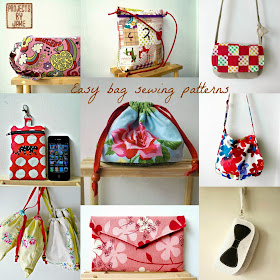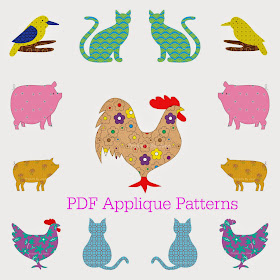If you want to be able to use your zigzag stitch well, you have to understand how the machine makes the stitch. On my machine, it starts with a locking stitch (the needle goes up and down a few times) before it makes a right stitch. Not every machine has locking stitch features so you need to try it out and see how yours work. So the zigzag stitch is pretty simple, the needle goes left and then goes right. Know that from R1 to L2, there will be a space depending on how long your stitch length is. Also know that L2 will never be perpendicular to R1. You need to remember this information especially when you are making stitches in difficult "terrain" like points or corners.
The look of your zigzag stitch can be adjusted to suit your liking. If your machine allows you to modify the stitch width and stitch length, you will be able to do the following:
- Stitch width changes the bite it takes
- Stitch length changes the space between each bite
On my Janome, I like to use these settings: width 3, length 0.5/0.4/1
I can't go any lower than a length of 0.4 as the stitches just get balled up. As a result my zigzags are not as close as satin stitch.
Speaking of satin stitch, if your machine has satin stitch, you'll need to check your manual to select the stitch and the recommended presser foot to use. Satin stitch should look much better than my zigzag stitch.
Next, lets talk about which foot to use. I should use the zigzag foot which is the default foot the machine comes in. But I don't. I have a satin foot which is used for decorative stitches. But I don't use it or the zigzag foot to sew zigzag stitches because the feet cover my stitches. That's why I use the open toe foot.
These are my "F" feet. (please excuse the dirty Ikea table top) The one on the left is my satin foot. The one on the right is my open toe foot.
Okay, I'm just going to talk about something that might be perculiar to me only. When my machine is set to zigzag stitch, the needle goes to the left position. This means my first stitch will be left. Logically, I would place my applique such that the LEFT needle goes into the background fabric right snug against the applique. (see image below) Right? If this is how you sew, I shall refer to you as a LEFTY.
But you know what? My brain feels very uncomfortable when I sew the applique this way (with the LEFT needle in the background fabric, snug against the applique).
Instead,I take a few test stitches and manually rotate the needle to be on the right when I sew on my applique. That way my RIGHT NEEDLE is the needle in the background fabric, snug against the applique. (I'm going to call myself a RIGHTY)
Beginnings and ends of threads
I don't back stitch and I bring the ends of thread to the back and knot off manually. I also like to begin stitching an applique at the least challenging position - something straight and definitely not at a point.
Things to consider
Thread: I use rayon embroidery thread and average weight thread for bobbin. Sometimes I just use regular sewing thread which I use for bags and clothes for top thread and bobbin.
Needle: I use embroidery needle size 75/11 or 90/14 for rayon and sharp needle size 80/12 for regular sewing thread.
Whatever thread you use, you need to match it to your needle.
Tension: Auto
If you need to adjust your tension, do refer to your machine manual.
Stabilizer : I always use stabilizer. If you don't have stabilizer, try with batting and interfacing. Never sew on one layer of fabric- puckering is bound to happen.
Needle down: Enable this feature. If not available, always rotate the needle to have the needle in the fabric when you stop sewing.
Inside and outside curves
You need to be able to tell the difference between an inside curve and an outside curve. See the shape below? What looks like a circle - that's the outside curve. The part that curves down (the curve in the middle) - that's the inside curve. To sew around curves, you will need to pivot from time to time and the position where you pivot for each kind of curve is different.
Needle position when pivoting for an outside curve
Needle should be in the background fabric only.
Needle down, lift presser foot, rotate applique slightly to the right (so the edge of applique aligns with the position of the right needle.
Needle position when pivoting for an inside curve
Needle should be in the applique
Needle down, lift presser foot, rotate applique slightly to the left (so the edge of applique aligns with the position of the right needle.
Outside and inside corners
Start anywhere except right at the corner. Here my stitch length is 1.0.
Sew like regular right up to the outside corner. It's better to go a little beyond the outside corner than before the corner. And by the way, since I'm a RIGHTY, the needle in the corner has to be in the RIGHT position. If you're a LEFTY, it will be in the LEFT POSITION.
The next stitch I make will go left. Now you see how it works?
Sew like regular.
Now we're coming to a inside corner. You want to sew beyond the corner by a couple of stitches.
You can pivot to see if your bite will be right at the edge of the applique. In this case, I'm a little short so I pivot back to the previous position and take another stitch. As I am a RIGHTY, I need my needle to be in the LEFT position before I pivot. For a LEFTY, you want it in the RIGHT position.
Yes, my bite will land my needle right at the edge of the applique.
Sew like regular.
End as close to your starting stitches as possible.
Time out: All these information might be overwhelming, LEFTY, RIGHTY, position of needle - for those of you who are new to zigzag stitching. But once you start trying it out, your brain will figure it out. The idea is to understand the techniques so that when things go wrong, you will have the ability to figure out why it went wrong.
From here on, I will only illustrate the stitches from a RIGHTY point of view.
What happens when you use a tight zigzag and you don't want your stitches to overlap?
Here's how for outside corners:
Sew right up to the end but end with needle on the left - i could have made 2 more stitches :(
Anyhoo, notice after pivoting, my needle is in the left position? If I make a stitch it won't hit the applique at all.
Solution: Lift presser foot and manually rotate the needle until it goes right.
Insert needle back where it came from. Presser foot down, continue sewing like regular.
The stitches do not overlap. (remember the extra bits of applique I missed? just cut off the bits)
Here's how if you don't want your stitches to overlap for inside corners:
Stitch right up to the corner but end with your needle in the left position.
Pivot. Notice your needle position is left but you want it on the right.
No worries. Presser foot up, manually rotate your needle till it goes right. Insert your needle right back where it came from.
Sew like regular.
No overlap.
Points are the hardest to sew. Use the following method for narrow points. If your points are fat enough, you can use the method used in corners.
Start anywhere except at the point.
As you get closer to the tip, you reduce the stitch width. (the bite) The idea is to keep your stitches as close to the applique edge as possible. Here I reduce from 3 to 2.5.
I reduce to 2 for the next 2 stitches and finally when I hit the tip, I am at 1.5 and I end with my needle on the right. (on my machine 1.5 is the lowest I go but you can try on yours and see what works for you)
I pivot and have my right needle lined up with the edge of the applique.
You must keep your eye on the right needle as you want it snug against the applique. As you move away from the tip, increase your stitch width (1.5 to 2, then 2.5 and finally 3 which is the stitch width I'm using)
If you are using a tighter zigzag stitch, the method is the same.
Before you start sewing on your applique, take a look at the shape - is it a curve, outside curve, inside curve, inside corner, etc. This helps you figure out how to sew. Lets take a heart for instance. It's mostly outside curve and the tip of the heart - you can take care of it like how you take care of a outside curve. But if the tip of the heart is really, really pointy, then use the method for the triangle. The other "tricky" part of the heart is the valley but it's really an inside corner.
Hope this long tute is helpful to beginners new to zigzag stitch.
**********************************************************************
Bag patterns at my Etsy shop

Applique patterns at my Etsy shop

For more Applique Resources
For more Tutorials





































This is way helpful! Hopefully I'll have no more messy corners.
ReplyDeleteApparently I'm a RIGHTY - I was scrolling through this post in my blog reader, looking at the pictures before coming to the website - when I first saw the applique shot with the needle on the left, I cringed a bit! It just felt wrong, and I had to read the post to see why, lol! I'm going to say that I'm definitely a RIGHTY :)
ReplyDeleteThose are some really good applique tips - I know I always forget to shorten my stitch length when I get to points - then I have zigzagging on the fabric instead of the applique - oops. It's very true that your brain will, after a bit of stitching, figure things out without you even concentrating - it's how I learned where to start/end on inside and outside curves - my brain reminds me each time :)
Very good instructions, Jane!
ReplyDeleteThank you so much for posting this...I was just trying the satin stitch on my new sewing machine and it really did not come out as nice as I had hoped. I will book mark this for future reference.
ReplyDeleteLinda
mysewwhatblog.blogspot.com
This was super helpful. What model is your Janome?
ReplyDeleteHi Kim, I use a Janome 6260 Quilter's Companion.
ReplyDeleteThis was most helpful. Thanks for taking the time to explain.
ReplyDeleteThis was very helpful! I just did a really tight zigzag stitch and no stabilizer. The puckering was horrible! I am making a quilt block and figured it would be easier to appliqué my block before putting quilt top all together. I had a feeling this would happen🤦♀️. When I loosened my zig zag a bit and not so tight it was a lot better. I love the look of the tighter zig zag but I only have done it with the batting and backing not just single layer fabric. Thank you for your tips!
ReplyDelete